What Does a Rainbow Symbolize Spiritually? Promise!
The rainbow is a powerful symbol in spirituality, signifying hope, promise, and enlightenment across a multitude of cultures and religious beliefs.
Rainbows are often seen as a link between the physical and the spiritual worlds. In Christianity, a rainbow represents God’s promise to Noah that He would never again flood the Earth.
In Hinduism, it’s associated with the god Indra, known as the bow for shooting arrows of lightning. Buddhism perceives the rainbow as a staircase enabling the Buddhas and Bodhisattvas to descend to Earth.
For Native American tribes, rainbows hold various meanings, from growth and fertility to bridges between the human and spirit worlds.
- Christianity: God’s covenant with Noah
- Hinduism: Indra’s bow
- Buddhism: Staircase for divine beings
- Native American spirituality: Connection and fertility
Embracing the rainbow’s spiritual essence, we find a universal message of transcendence, diversity, and the harmonious balance of life’s tapestry.
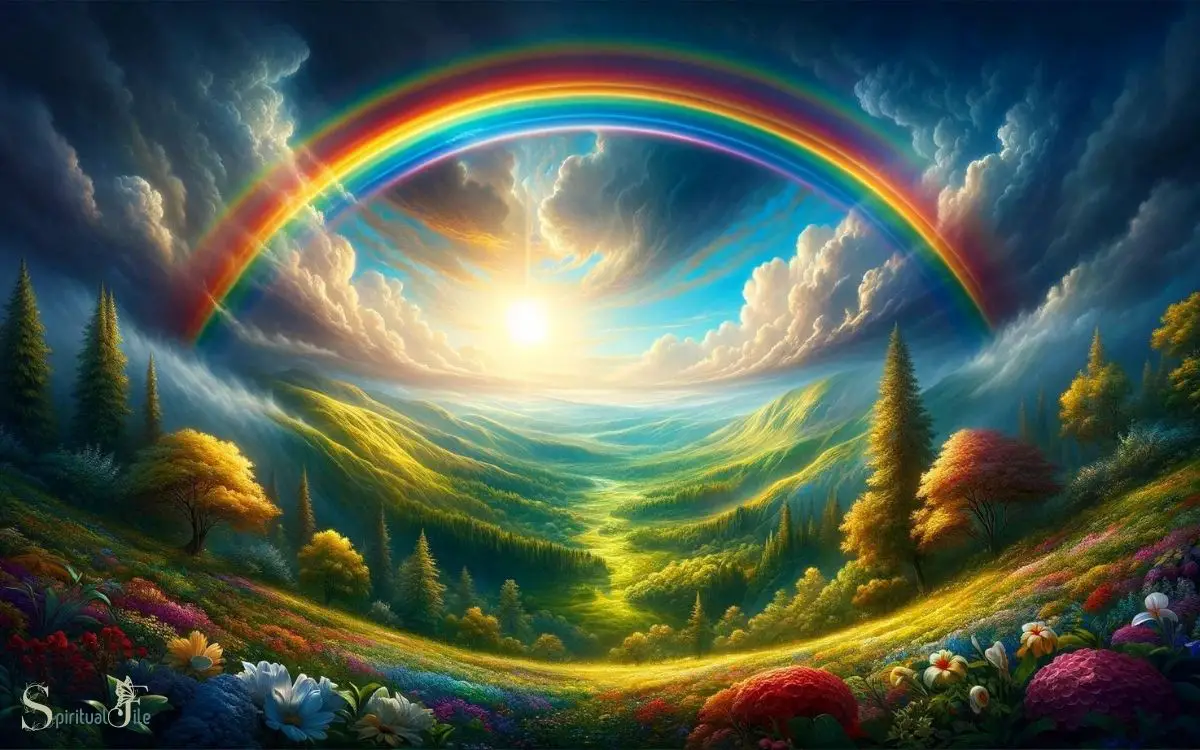
Key Takeaway
The Origin of Rainbow Symbolism
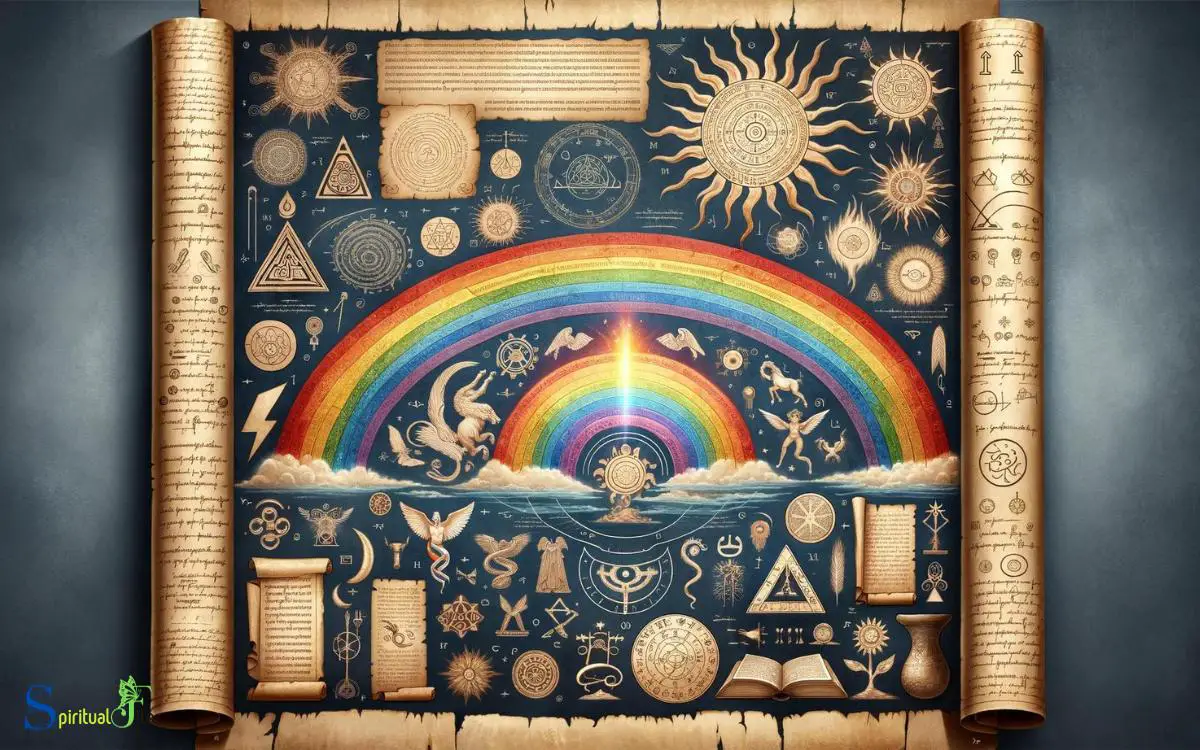
The origin of rainbow symbolism can be traced back to various ancient cultures and religious traditions, where the rainbow was often interpreted as a divine sign or message.
In many ancient belief systems, the rainbow was seen as a bridge between the earthly and spiritual realms, a manifestation of celestial beauty and wonder.
In Norse mythology, the rainbow was a bridge between the world of humans and the realm of the gods. In Greek and Roman traditions, the rainbow was considered to be a path made by a messenger between Earth and Heaven.
Similarly, in Hindu and Buddhist cultures, the rainbow holds deep spiritual significance, symbolizing the bridge between the material and the spiritual worlds.
Across diverse cultures, the rainbow has consistently been revered as a symbol of hope, transformation, and divine communication.
Rainbow Symbolism in Christianity
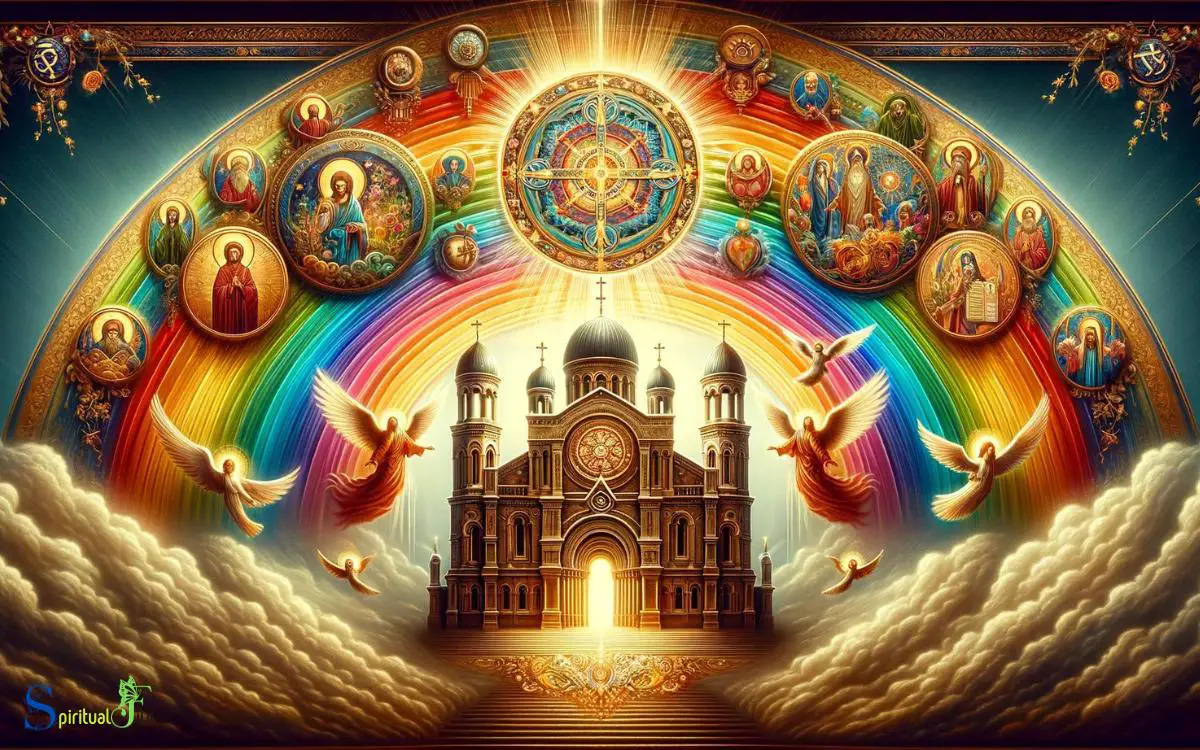
In Christianity, the rainbow holds significant symbolism. It represents God’s covenant and promise to never again flood the earth as seen in the story of Noah in the Old Testament.
The rainbow also signifies the divine presence and grace of God, serving as a reminder of His mercy and faithfulness. Additionally, the rainbow is often seen as a symbol of hope, particularly in times of adversity. It reflects the belief in the fulfillment of God’s promises.
Biblical Covenant and Promise
Symbolizing God’s covenant and promise, the rainbow holds significant spiritual meaning in Christianity. In the Bible, the rainbow is depicted as a symbol of God’s promise to never again destroy the earth by flood.
This covenant between God and humanity is found in the book of Genesis, where the rainbow is described as a sign of hope and renewal.
The following table provides a summary of the symbolism of the rainbow in Christianity:
| Symbol | Meaning |
|---|---|
| Rainbow | God’s promise |
| Colors | Faithfulness and mercy |
| Renewal | Hope and new beginnings |
| Covenant | Unchanging commitment |
The rainbow’s appearance after the flood signifies God’s faithfulness and mercy towards His creation, conveying a message of hope and new beginnings. This covenant is a powerful reminder of God’s unchanging commitment to His people.
Moving forward, the subsequent section will delve into the concept of divine presence and grace.
Divine Presence and Grace
A significant aspect of Christian symbolism, the rainbow represents divine presence and grace in a spiritual context. In Christianity, the rainbow is a powerful sign of God’s presence and His grace towards humanity.
The rainbow serves as a reminder of God’s faithfulness and His covenant with His people. It symbolizes the unchanging nature of God and His everlasting love for humanity.
The presence of the rainbow is seen as a reflection of God’s mercy and forgiveness, offering hope and comfort to those who seek His divine presence.
It is a visual representation of the grace that God bestows upon His creation, highlighting the beauty of His love and the promise of His eternal presence. This symbolism is deeply rooted in Christian theology and is a source of spiritual strength and reassurance for believers.
This divine presence and grace, as symbolized by the rainbow, seamlessly transitions into the subsequent section about the rainbow being a symbol of hope.
Symbol of Hope
The rainbow, as a powerful symbol in Christianity, embodies the concept of hope and serves as a tangible manifestation of God’s enduring promise to His people.
In the Bible, the rainbow is depicted as a symbol of hope, particularly in the story of Noah and the Great Flood. After the floodwaters receded, God displayed a rainbow as a covenant with Noah, promising that He would never again flood the earth to the same extent.
This act of divine grace and promise signifies hope, renewal, and the faithfulness of God. For Christians, the rainbow is a reminder of God’s faithfulness, His unchanging nature, and the hope that is found in His promises.
It symbolizes the assurance that God’s love and grace will prevail, providing comfort and encouragement in challenging times.
Rainbow Symbolism in Hinduism
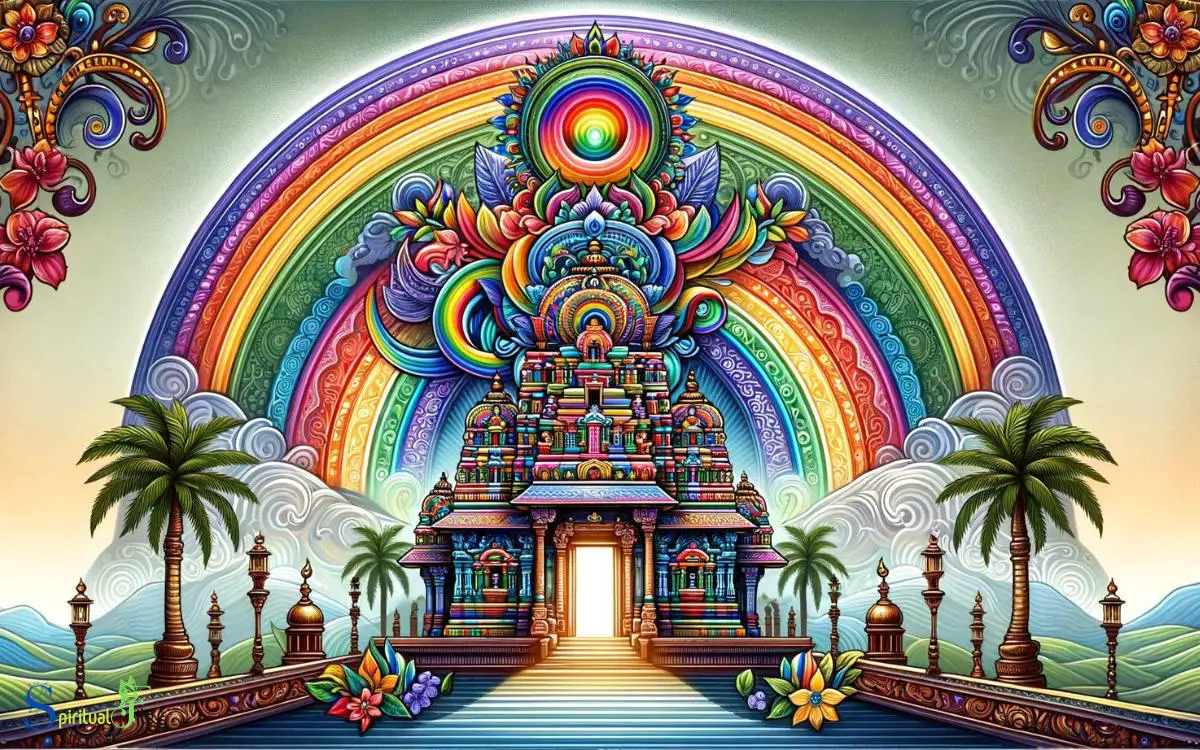
Rainbows hold significant spiritual symbolism in Hinduism, representing the manifestation of divine beauty and the harmonious balance of cosmic energies.
In Hindu culture, the rainbow is thought to symbolize the bridge between the earthly and spiritual realms, connecting humans with the divine.
Here are three key aspects of rainbow symbolism in Hinduism:
- Representation of Divine Blessings: The appearance of a rainbow is often seen as a blessing from the gods, signifying their presence and protection.
- Sign of Promise and Renewal: Rainbows are associated with the promise of positive change and renewal, signifying the end of challenges and the beginning of a new, harmonious phase.
- Symbol of Unity and Diversity: The vibrant and diverse colors of the rainbow symbolize the unity and diversity present in the cosmos, emphasizing the interconnectedness of all life.
The deep spiritual significance of rainbows in Hinduism reflects the profound reverence for nature and the divine in Hindu culture.
Transitioning to the subsequent section about ‘rainbow symbolism in native American spirituality,’ we can explore how this natural phenomenon holds spiritual importance across different cultures and traditions.
Rainbow Symbolism in Native American Spirituality
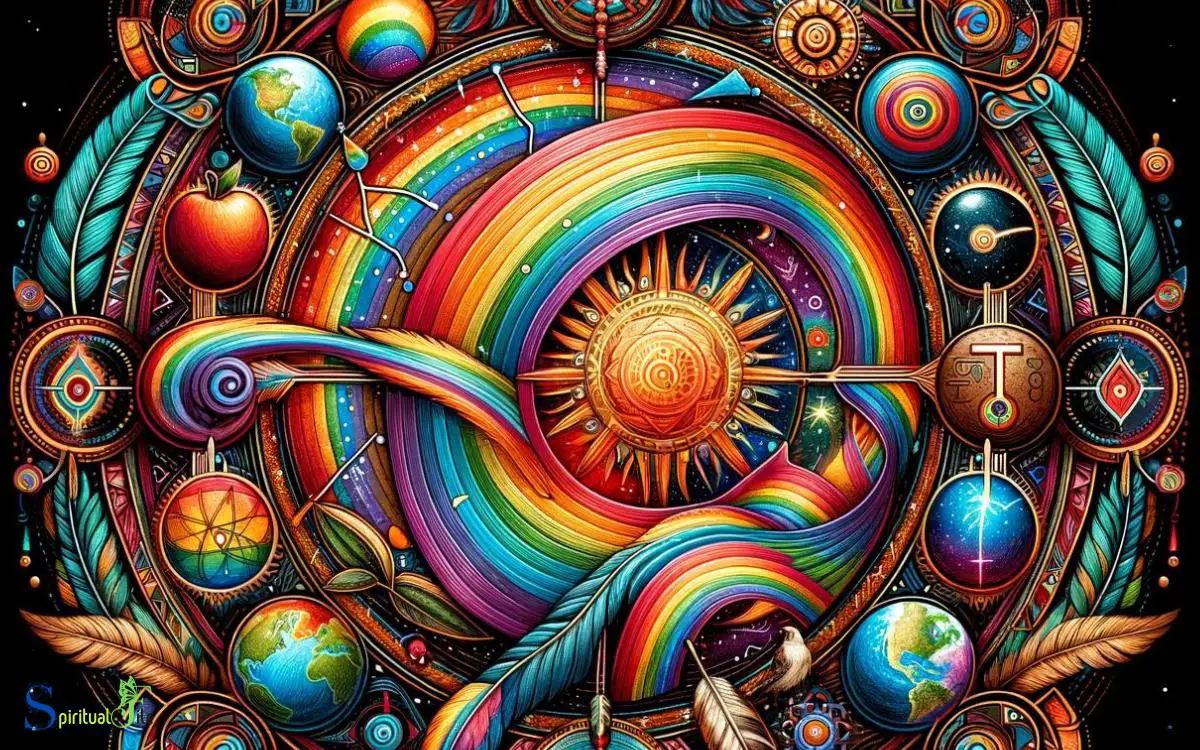
In Native American spirituality, the rainbow holds deep significance as a symbol of the sacred connection to nature. It represents spiritual balance and harmony, reflecting the interconnectedness of all living beings and the natural world.
Additionally, the rainbow is seen as a conduit for divine messages and guidance, serving as a bridge between the earthly and spiritual realms.
Sacred Connection to Nature
Native American spirituality holds a deep reverence for the sacred connection to nature, with the rainbow symbolizing a powerful and spiritual link to the natural world.
In Native American spirituality, the symbolism of the rainbow is deeply intertwined with the natural elements and the spiritual realm.
The rainbow is seen as a bridge between the physical and spiritual worlds, symbolizing unity and harmony.
This sacred connection to nature is reflected in the following aspects:
- Cosmic Balance: The rainbow is considered a manifestation of the harmonious balance in the universe, representing the interconnectedness of all living beings and the natural world.
- Spiritual Guidance: It is believed to be a path for spiritual guidance, offering a connection to the divine and a reminder of the sacredness of nature.
- Renewal and Healing: The rainbow is associated with renewal, healing, and transformation, signifying the cyclical nature of life and the interconnectedness of all living things.
Spiritual Balance and Harmony
Within Native American spirituality, the symbolism of the rainbow is deeply ingrained as a representation of spiritual balance and harmony, reflecting a profound connection to the natural world.
The rainbow holds significant spiritual meaning, embodying the harmonious integration of the physical, mental, and spiritual aspects of existence.
This symbolism is often depicted in Native American art, stories, and rituals, emphasizing the importance of maintaining equilibrium within oneself and with the surrounding environment.
| Aspect | Representation |
|---|---|
| Connection to Nature | Deep affinity with the natural world |
| Inner Peace and Tranquility | Serenity and calm within |
| Interconnectedness with All Life | Unity and harmony with all living beings |
| Alignment of Mind, Body, and Spirit | Balancing and aligning mental, physical, and spiritual aspects |
| Respect for the Earth and its Gifts | Reverence for the planet and its blessings |
This profound symbolism serves as a guiding principle for living in harmony with nature and fostering a balanced and interconnected spiritual life.
The rainbow’s significance in Native American spirituality extends far beyond its visual beauty, encompassing a holistic approach to existence and interconnectedness between all living beings.
Transitioning into the subsequent section about ‘divine messages and guidance’, the spiritual symbolism of the rainbow also holds deep significance in conveying messages and guidance from the divine realm.
Divine Messages and Guidance
The symbolism of the rainbow in Native American spirituality extends to conveying divine messages and guidance, reflecting a profound connection to the natural world and the interconnectedness between all living beings.
In this context, the rainbow holds significant spiritual meaning, serving as a conduit for divine communication and guidance.
This symbolism is manifested through:
- Harmony and Balance: The rainbow symbolizes the balance and harmony that exist within the natural world and the importance of maintaining equilibrium within oneself and with all living beings.
- Protection and Blessings: It is seen as a sign of protection and blessings from the spirits, guiding individuals along their spiritual paths and offering them comfort and reassurance.
- Renewal and Transformation: The rainbow signifies the cyclical nature of life, representing renewal, transformation, and the interconnectedness of all life forms.
This profound symbolism of the rainbow in Native American spirituality emphasizes the spiritual interconnectedness and guidance that is believed to be inherent in the natural world.
As we delve into the symbolism of rainbows in various spiritual traditions, the next section will explore the significance of rainbows in Buddhism.
Rainbow Symbolism in Buddhism
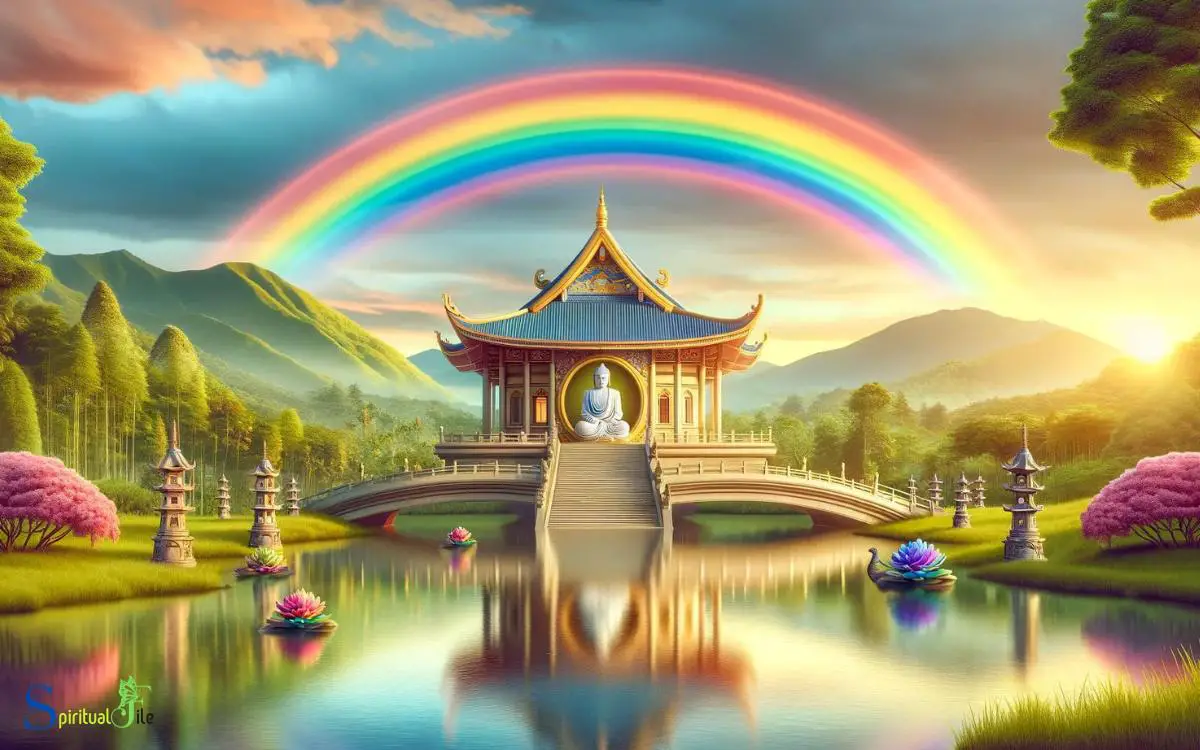
In Buddhism, the rainbow is often regarded as a symbol of the highest state of consciousness and enlightenment.
The rainbow holds significance in Buddhist culture, representing the unification of all colors and elements, which parallels the harmonious integration of all aspects of life.
It is also associated with the concept of the rainbow body, a symbol of the ultimate realization of the nature of mind and the attainment of spiritual perfection.
This symbolism emphasizes the transformative journey towards enlightenment and the interconnectedness of all beings.
The rainbow serves as a powerful reminder of the potential for spiritual growth and the transcendence of suffering. Understanding its symbolism in Buddhism provides insight into the pursuit of wisdom and compassion.
Now, let’s explore the symbolism of the rainbow in pagan traditions.
Rainbow Symbolism in Pagan Traditions
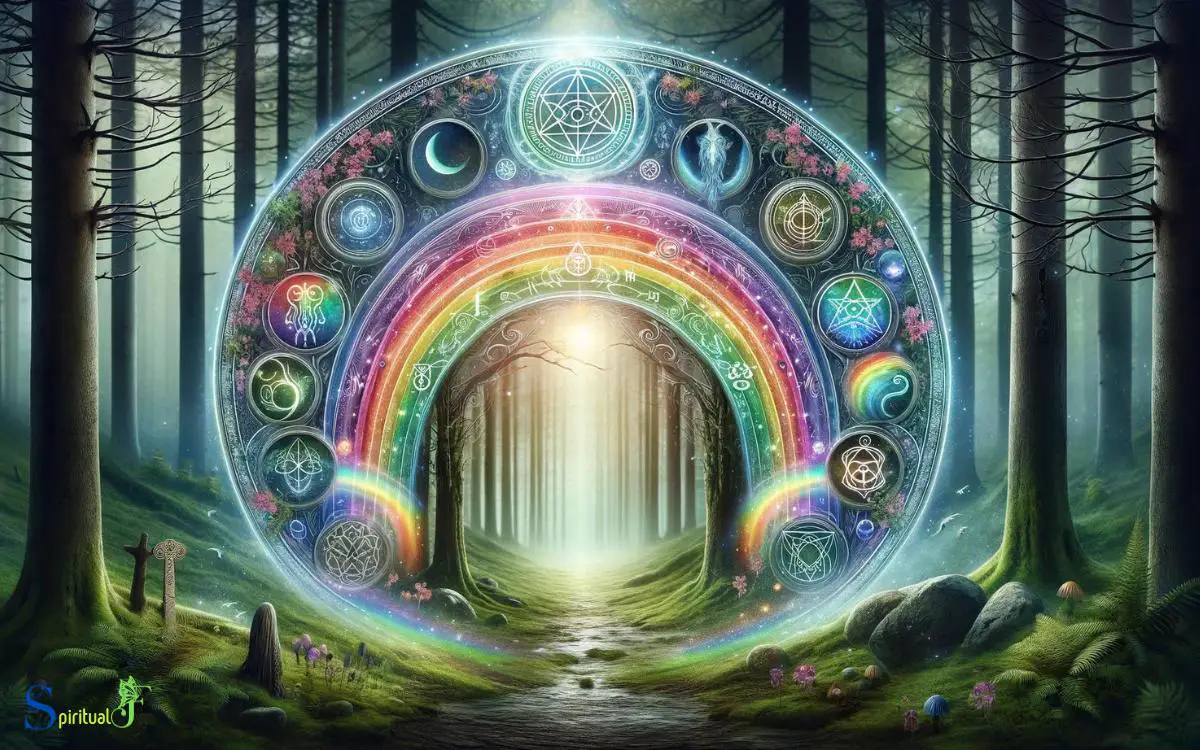
Building upon the previous subtopic on Rainbow Symbolism in Buddhism, the rainbow holds significance in pagan traditions as a symbol of divine connection and spiritual energy.
In pagan cultures, the rainbow is often associated with various deities and spiritual beliefs, representing the following:
Bridge Between Worlds: Pagan traditions view the rainbow as a bridge that connects the earthly realm with the divine or supernatural realms, symbolizing a link between humans and the spiritual world.
Renewal and Transformation: The appearance of a rainbow is seen as a sign of renewal and transformation, signifying the cyclical nature of life, death, and rebirth in pagan beliefs.
Harmony and Balance: Pagan symbolism interprets the rainbow as a representation of harmony and balance, reflecting the interconnectedness of all things in the natural world.
As we delve into ‘the meaning of rainbow colors’, it becomes evident how the various hues hold distinct spiritual significance.
The Meaning of Rainbow Colors
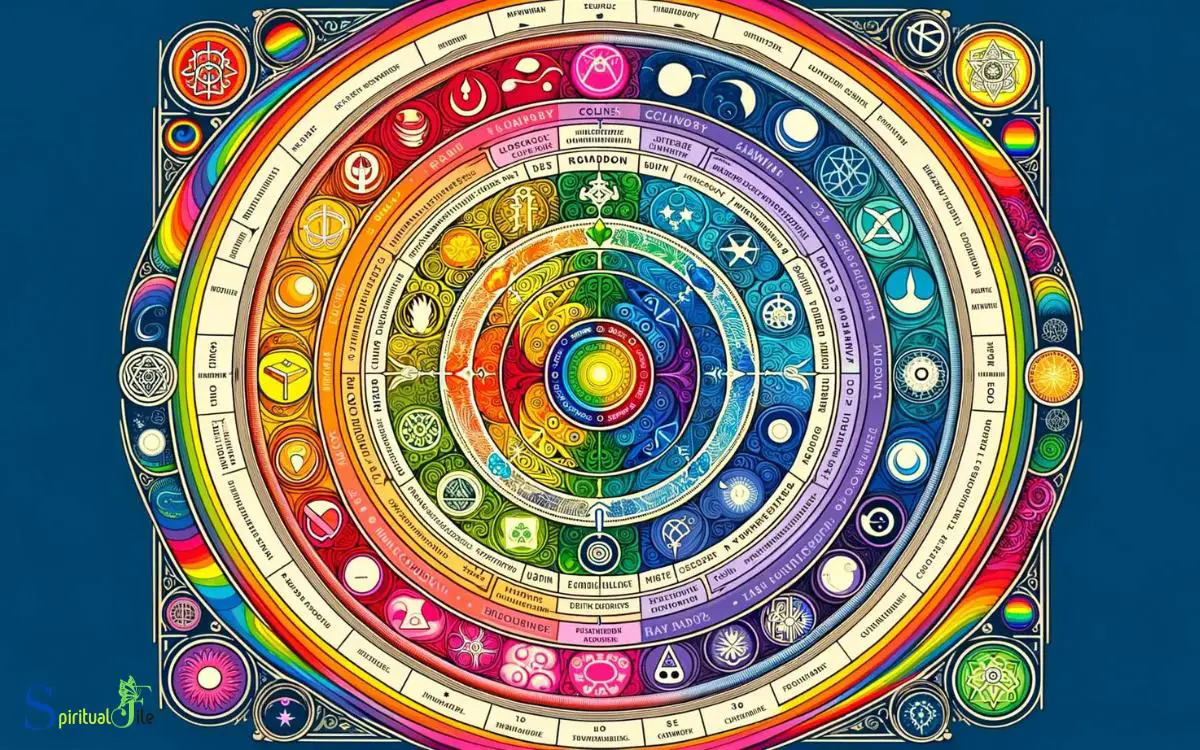
Expanding upon the significance of the rainbow in pagan traditions, the meaning of rainbow colors holds distinct spiritual significance, reflecting various aspects of divine connection and symbolic representation. Each color within the rainbow carries its own symbolism.
Red signifies passion, energy, and life force. Orange represents creativity, joy, and enthusiasm. Yellow symbolizes wisdom, clarity, and optimism.
Green embodies balance, growth, and renewal. Blue reflects truth, communication, and spiritual expansion. Indigo signifies intuition, insight, and perception. Violet represents spirituality, transformation, and connection to higher realms.
Together, the rainbow colors symbolize a harmonious integration of these diverse qualities, reflecting the unity and interconnectedness of all aspects of existence.
Understanding the spiritual significance of rainbow colors can offer insight into the diverse and multifaceted nature of the divine and its presence in the world.
Is There a Spiritual Symbolism Behind Rainbows and Water?
Rainbows are often associated with purity, wonder, and divine beauty. In many cultures, they symbolize a bridge between the physical and spiritual realms. Water, on the other hand, represents life, renewal, and cleansing. The spiritual symbolism of water and rainbows together signifies a powerful connection between the earthly and the divine.
Interpreting the Rainbow Symbolism
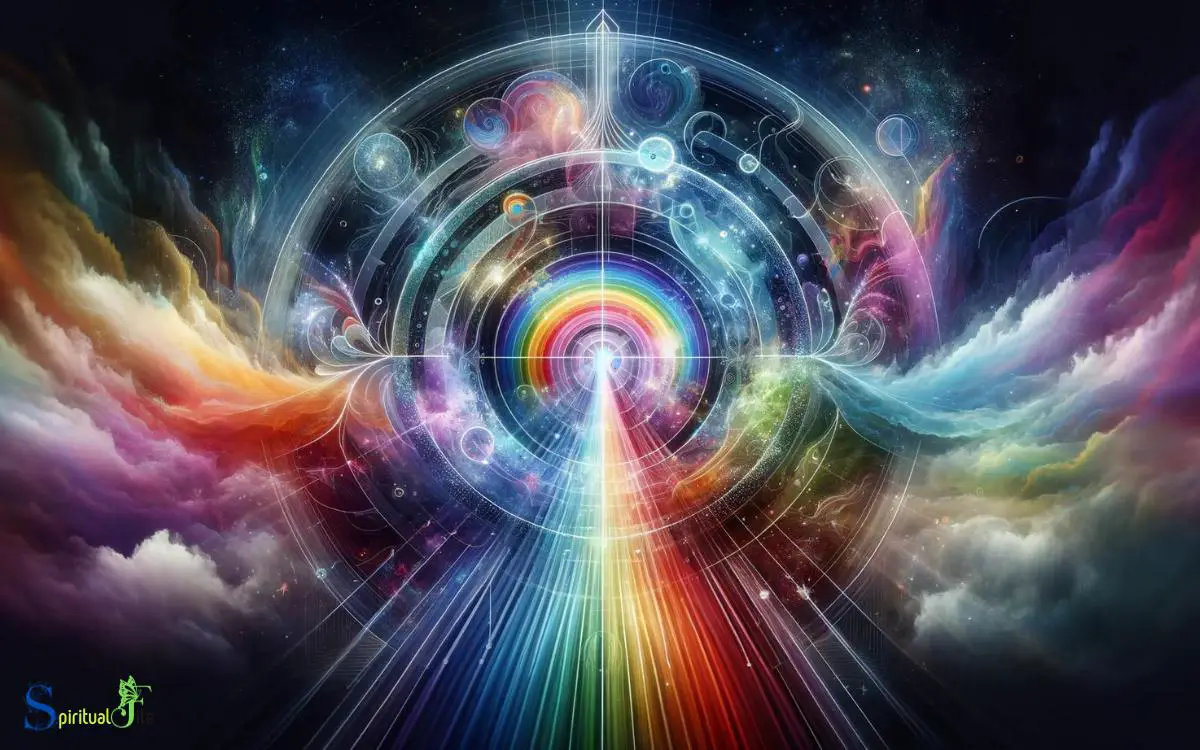
The symbolism of the rainbow extends beyond its colors, reflecting a profound interconnectedness between the divine and the natural world.
Interpreting the rainbow symbolism reveals deeper spiritual meanings:
- Harmony and Unity: The rainbow is often seen as a symbol of harmony and unity, representing the coming together of different elements to create a beautiful whole.
- Promises and Hope: In many cultures, the rainbow symbolizes hope and the fulfillment of promises. It is often seen as a sign of positivity and a brighter future after a period of darkness or challenge.
- Spiritual Transformation: The appearance of a rainbow is sometimes interpreted as a message of spiritual transformation and growth, signifying a journey towards enlightenment and higher consciousness.
Conclusion
The symbolism of the rainbow is deeply rooted in various spiritual traditions around the world, representing hope, transformation, and divine connection.
As the saying goes, ‘After the rain, comes the rainbow,’ reminding us that even in the darkest times, there is always the potential for beauty and blessings to emerge.
The spiritual significance of the rainbow serves as a powerful reminder of the interconnectedness of humanity and the natural world.






